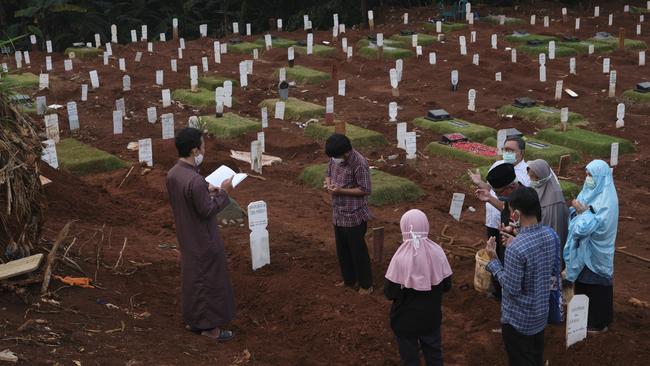Coronavirus: Graveside view tells a different story than official Indonesian statistics
For two months, Jakarta grave digger Junaidi has been working 15-hour days to keep up with the number of bodies brought for burial.

For two months, Jakarta grave digger Junaidi has been working 15-hour days trying to keep up with the number of bodies brought for burial in the cemetery where he has worked for 20 years.
Week after week, his team of 50 has toiled the freshly bulldozed-ground of first one, then two, then three newly created COVID-19 sections, digging burial pits for 30 or more bodies every day in stifling plastic suits they now wear to protect themselves from the virus.
Even in the rich tropical soil of the Pondok Rangon cemetery on Jakarta’s eastern fringe, it can take two hours to dig and prepare a single grave for burial.
Yet in the past week there has been a noticeable slowdown.
“In March, there was one day where we received 32 bodies that had to be buried according to COVID-19 protocols,” Junaidi told The Australian on Wednesday.
“It’s a little better now. I think at the most we have received 20 COVID-19 bodies in one day, but last month receiving 20-30 bodies was normal. Now we are receiving on average eight to 12 bodies daily. It feels like we can finally take a breath.”
As the flow of ambulances ferrying the dead has eased some graveyard humour has seeped in.
The 42-year-old father of four says his team now keeps 10 graves open and ready but “we now joke that we are digging more graves than there are bodies to fill them”.
“Some people don’t understand the complete situation with this disease, but we are seeing the end result of it … the dead bodies and the families left behind, and it’s heartbreaking. Seeing the numbers go lower in recent days, I feel the situation is improving.”
It is difficult to say whether that is truly the case and whether the infection rate in Jakarta — the epicentre of Indonesia’s COVID-19 outbreak — has reached its peak.
The government’s COVID-19 taskforce chief, Doni Monardo, said on Monday that Indonesia’s daily infection figures had fallen 11 per cent in recent days, only for 484 new cases to be confirmed the next day — the highest single 24-hour rise since the first reported case on March 2. Indonesia’s total caseload is now 12,438.
A Reuters investigation of burials in the Indonesian capital, using data from the Jakarta’s parks and cemeteries department, has found at least 2500 more people died in the city in March and April than the average for the same period in previous years.
That is more than six times Jakarta’s official COVID-19 death toll of 414 people out of 895 nationwide. The city’s own statistics show, as of Monday, 1695 people had been buried according to COVID-19 protocols.

Jakarta’s burial figures appear to support Junaidi’s suspicion that deaths in the capital may be falling. The number of people buried according to COVID-19 protocols in its two designated cemeteries have fallen from a daily average of 57 a month ago to 33 last week.
University of Indonesia epidemiologist Pandu Riono said that was “not statistically significant” and a slowdown in Jakarta burials could indicate the epicentre of Indonesia’s COVID-19 outbreak had moved, along with the more than one million people who fled the city ahead of a lockdown to prevent the traditional mass homecoming for this month’s Eid holiday.
“Also, the number of suspected COVID-19 deaths is still increasing because the amount of testing being done cannot catch up with the increasing number of people dying from suspected COVID-19,” he said.
The World Health Organisation recommended last month that all countries report suspected, as well as confirmed, COVID-19 deaths.
The new reporting guidelines are particularly important for countries such as Indonesia, which has limited testing capacity and prioritises what tests it does have for the living, says Dr Pandu.
Most Indonesian provinces have yet to comply with those recommendations, although the statistics are revealing.
Central Java province had confirmed 74 deaths from COVID-19 as of Wednesday but also reported 452 suspected deaths from the disease, while East Java reported 123 confirmed deaths and 336 suspected deaths.


